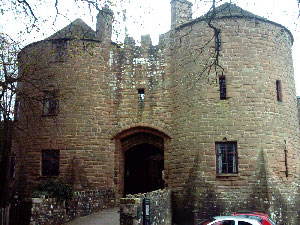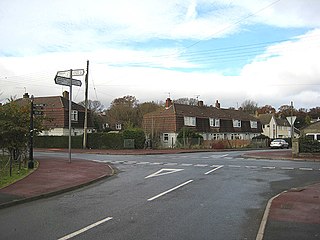
Freeminer is an ancient title given to coal or iron miners in the Forest of Dean, Gloucestershire, England, who have earned the right to mine personal plots, known as gales.

Freeminer is an ancient title given to coal or iron miners in the Forest of Dean, Gloucestershire, England, who have earned the right to mine personal plots, known as gales.
For hundreds of years, mining of the Forest of Dean Coalfield and iron reserves has been regulated through a system of Freemining, with the Free Miner's Mine Law Court sitting at the Speech House from 1682. The earliest known existing copy of Dean Miners’ Laws and Privileges, known locally as the Book of Dennis, dates from 1610 but the copy itself contains references to much earlier origins. [1] It also claims that Freemining rights were granted to Foresters by Edward I who, in so doing, also confirmed that such 'customes and franchises' had existed since 'tyme out of mynde'. [2] Freeminers had been instrumental in recapturing Berwick-upon-Tweed several times (1296, 1305 and 1315) and it is thought that these privileges were granted as a reward for their endeavours.
A plaque bearing the engraved coat of arms of the Freeminers is on the Greyndour tomb in the Clearwell Chapel in Newland church, and other important medieval and modern mining emblems are in the Freeminers Guild church of St. Michael in Abenhall.
Towards the end of the 18th century, as the industrial revolution began to take hold, increasing demand for coal and iron led to conflicting mining interests and the Mine Law Court became bogged down with disputes. Deep coal and iron reserves could not be mined without substantial investment and the Crown became determined to introduce the free market into the Forest. In 1777 Mine Law Court documents mysteriously disappeared from the Speech House where they were stored and the court fell into disarray. Most of the Court documents were later found to have been in the possession of local Crown officials (Deputy Gavellers), and they were produced as evidence at an inquiry some 50 years later. [3]
| Dean Forest Mines Act 1838 | |
|---|---|
| Act of Parliament | |
 |
A royal commission was appointed in 1831 to inquire into the nature of the mineral interests and freemining customs in the Forest of Dean, leading to the passing of the Dean Forest Mines Act 1838, [4] which now forms the basis of Freemining law. It confirmed the Freeminers' exclusive right to the minerals of the Forest of Dean, but also allowed Freeminers to sell their gales to a non-Freeminers, weakening the Freeminer's control and opening up the forest to outside industrialists.
The Coal Industry Nationalisation Act 1946 specifically exempted the Forest of Dean, due to its unique form of ownership and history, allowing Freemining privileges to continue intact. Some large colliery gales were subsequently compulsorily purchased by the National Coal Board (NCB), but these remained under the Freemining system, with a royalty paid to the Freeminers, by the NCB, as a share of the minerals extracted. The last of the NCB deep mines closed in 1965. [3]
"All male persons born or hereafter to be born and abiding within the said Hundred of St Briavels, of the age of twenty one years and upwards, who shall have worked a year and a day in a coal or iron mine within the said Hundred of St Briavels, shall be deemed and taken to be Free Miners." the Dean Forest (Mines) Act 1838. [5]
This qualification has recently been challenged on the grounds of sex discrimination and although legal opinion advised that the 1838 Act was not subject to Equal Rights legislation, the Forestry Commissioners who act as Gaveller of the Forest of Dean made the decision to enter females onto the register for the first time in 2010. It is now understood that the qualification of "male", also incorporates "or female."
The ancient administrative district, known as the "Hundred of St Briavels", is generally considered to be the whole of the statutory Forest of Dean and each parish adjoining it. And, as of 2010, the gender requirement has been recognised as archaic and women are now allowed to become freeminers. [6]
The Dean Forest Mines Act is the basis for Free Mining today and Freemining is administered by the Deputy Gaveller; a post established in Medieval times, recently held by Chartered mining engineer John Harvey MBE (retired March 2011), and succeeded by Daniel Howell. [7]
There are probably still around 150 Freeminers alive today, only one of which is female, although only a handful of collieries are still operating, [3] due to the demanding nature and relatively high costs of small-scale extraction; the closure of maternity hospital facilities at the Dilke Hospital - so that it has become unusual to be born within the "Hundred of St Briavels" - and attempts by the UK government to exact commercial coal mining licence charges under the 1994 Coal Act adds further difficulties.
Despite the modest level of activity, some Freemines do operate successfully, especially through diversification into non-traditional areas such as tourism and ochre mining. Freemining continues to be an important aspect of Forest of Dean culture and an important part of local identity.

The Forest of Dean is a geographical, historical and cultural region in the western part of the county of Gloucestershire, England. It forms a roughly triangular plateau bounded by the River Wye to the west and northwest, Herefordshire to the north, the River Severn to the south, and the City of Gloucester to the east.

Cinderford is a town and civil parish on the eastern fringe of the Forest of Dean in Gloucestershire, England. The population was 8,777 at the 2021 Census.

The National Coal Board (NCB) was the statutory corporation created to run the nationalised coal mining industry in the United Kingdom. Set up under the Coal Industry Nationalisation Act 1946, it took over the United Kingdom's collieries on "vesting day", 1 January 1947. In 1987, the NCB was renamed the British Coal Corporation, and its assets were subsequently privatised.

St Briavels, is a medium-sized village and civil parish in the Royal Forest of Dean in west Gloucestershire, England; close to the England-Wales border, and 5 miles (8 km) south of Coleford. It stands almost 800 feet (240 m) above sea level on the edge of a limestone plateau above the valley of the River Wye, above an ancient meander of the river. To the west, Cinder Hill drops off sharply into the valley. It is sheltered behind the crumbling walls of the 12th century St Briavels Castle.

Abenhall is a small village and former civil parish, now in the parish of Mitcheldean, in the Forest of Dean district, in the county of Gloucestershire, England. It lies on the road between Mitcheldean and Flaxley in the Forest of Dean. The parish included the settlement of Plump Hill, which is actually more populous than Abenhall itself, and was once part of the Hundred of St Briavels. Originally a mining and iron-making centre like much of the surrounding area, the village is notable for its 14th century Church of St Michael, which is built of local red sandstone and has ornate contemporary carvings relating to the Forest of Dean's principal industries. These include a shield bearing the arms of the Freeminers on the west wall and a mid-15th century octagonal font, that has tools of miners and metalworkers incised on its sides. Abenhall is a tiny, ancient village in a secluded quiet valley near Mitcheldean. The parish includes the settlement of Plump Hill, on the Mitcheldean to Cinderford Road as it climbs into the high Forest. Abenhall is on the Flaxley to Mitcheldean Road. Originally a mining and iron making centre, it is notable for its 14th century Church of St Michael, which is built of local red sandstone and has excellent contemporary carvings relating to the Forest of Dean's industries. These include a shield bearing the arms of the Freeminers on the west wall and the fabulous mid-15th century octagonal font, that has tools of miners and metalworkers incised on its sides. In the west tower is a spectacular new window installed 14 April 2011 by stained glass artist Thomas Denny; presented by the current free miners of the Forest of Dean to represent their gratitude and present day continuation of the ancient local customs of coal, iron ore and stone mining. In 1931 the parish had a population of 230.

The Dean Heritage Centre is located in the valley of Soudley, Gloucestershire, England in the Forest of Dean and exists to record and preserve the social and industrial history of the area and its people. The centre comprises the museum itself, a millpond and waterwheel, forester's cottage with garden and animals, art and craft exhibitions and workshops, and trails around the surrounding woodland. In addition, there are picnic tables, barbecue hearths, an adventure playground, a gift shop selling local produce and the Heritage Kitchen, a restaurant providing home-made food.

Clearwell is a village and former ancient manor in the Forest of Dean, West Gloucestershire, England. A recent survey indicated that the population of Clearwell is approximately 350.

Mining in Wales provided a significant source of income to the economy of Wales throughout the nineteenth century and early twentieth century. It was key to the Industrial Revolution in Wales.
The South Yorkshire Coalfield is so named from its position within Yorkshire. It covers most of South Yorkshire, West Yorkshire and a small part of North Yorkshire. The exposed coalfield outcrops in the Pennine foothills and dips under Permian rocks in the east. Its most famous coal seam is the Barnsley Bed. Coal has been mined from shallow seams and outcrops since medieval times and possibly earlier.

Steam Mills is a village in the Forest of Dean, west Gloucestershire, England.

Sling is a village in Gloucestershire, England. The village is located between Clearwell and Bream. It is just south of the village of Milkwall.
The Minnie Pit disaster was a coal mining accident that took place on 12 January 1918 in Halmer End, Staffordshire, in which 155 men and boys died. The disaster, which was caused by an explosion due to firedamp, is the worst ever recorded in the North Staffordshire Coalfield. An official investigation never established what caused the ignition of flammable gases in the pit.

Coal mining in the United Kingdom dates back to Roman times and occurred in many different parts of the country. Britain's coalfields are associated with Northumberland and Durham, North and South Wales, Yorkshire, the Scottish Central Belt, Lancashire, Cumbria, the East and West Midlands and Kent. After 1972, coal mining quickly collapsed and had practically disappeared by the 21st century. The consumption of coal – mostly for electricity – fell from 157 million tonnes in 1970 to 18 million tonnes in 2016, of which 77% was imported from Colombia, Russia, and the United States. Employment in coal mines fell from a peak of 1,191,000 in 1920 to 695,000 in 1956, 247,000 in 1976, 44,000 in 1993, and to 2,000 in 2015.

The Lancashire Coalfield in North West England was an important British coalfield. Its coal seams were formed from the vegetation of tropical swampy forests in the Carboniferous period over 300 million years ago.
The Astley and Tyldesley Collieries Company formed in 1900 owned coal mines on the Lancashire Coalfield south of the railway in Astley and Tyldesley, then in the historic county of Lancashire, England. The company became part of Manchester Collieries in 1929 and some of its collieries were nationalised in 1947.


Sir Baynham Throckmorton, 3rd Baronet of Clearwell, Gloucestershire was an English politician who sat in the House of Commons at various times between 1656 and 1679.

Bradford Colliery was a coal mine in Bradford, Manchester, England. Although part of the Manchester Coalfield, the seams of the Bradford Coalfield correspond more closely to those of the Oldham Coalfield. The Bradford Coalfield is crossed by a number of fault lines, principally the Bradford Fault, which was reactivated by mining activity in the mid-1960s.
Coventry Colliery was a coal mine located in the village of Keresley End in northern Warwickshire, between Bedworth and Coventry, England. Closed in 1991, the site today has been redeveloped as a distribution park, owned by Prologis.
Coal mining played an important part in the history of the Black Country area immediately west of Birmingham, England. It was the basis for the area's industrial development in the nineteenth century; without coal there was insufficient power. Commentators spoke of the Black Country as a great coalfield, and of the earth turned inside out by all the mining activity. Most of the mines were not large scale, but small rough and ready pits similar to the Racecourse Colliery exhibit at the Black Country Living Museum. There were as many as five or six hundred small pits like this exploiting the seams of the South Staffordshire coalfield.